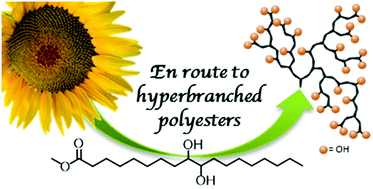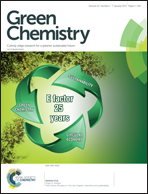Hyperbranched polyesters by polycondensation of fatty acid-based ABn-type monomers†
Abstract
Widely available vegetable oils were readily derivatized into chemically pure ABn-type monomers (n = 2 or 3). Their polymerization led to unprecedented hyperbranched polyesters. Four different AB2/AB3-type monomers bearing one A-type methyl ester and two or three B-type alcohol functions were purposely synthesized via two elementary steps, i.e. epoxidation of the internal double bond of the vegetable oil precursors followed by ring-opening of the epoxy groups under acidic conditions. The polycondensation of these bio-sourced monomers was performed in bulk, in the presence of an appropriate catalyst, giving access to modular hyperbranched polyesters with tunable properties. Among the catalysts tested, zinc acetate, 1,5,7-triazabicyclo[4.4.0]dec-5-ene (TBD) and sodium methoxide proved the most effective, allowing the achievement of molar masses in the range 3000–10 000 g mol−1 and dispersities varying from 2 to 15, depending on the initial conditions. The degree of branching, DB, as determined by 1H NMR spectroscopy, was found to be between 0.07 and 0.45. The as-devised hyperbranched polyesters displayed either amorphous or semi-crystalline properties, as a function of the selected AB2/AB3-type initial monomers, with a glass transition temperature, Tg, ranging from −33 to 9 °C and a decomposition temperature at 5 wt% of the sample, Td5%, varying from 204 to 340 °C.


 Please wait while we load your content...
Please wait while we load your content...